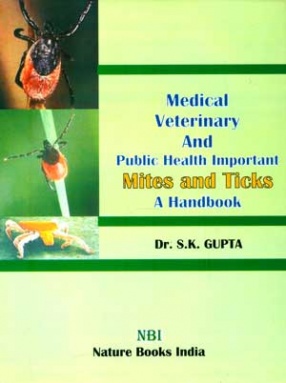
S.K. Gupta

51 books











Land and water, the two crucial natural resources for agriculture, are decreasing as a result of burgeoning population of the country. At the same time, various forms of degradation are taking a toll on the productivity of these resources so much so that large areas have been taken out of plough. Current assessment reveal that already 6.73 million ha area has gone out of cultivation because of excessive salts or high sodicity and this area is likely to expand to ...

The book entitled "Diseases of Vegetable, Ornamental and Spice crops" is specifically prepared for under-graduate and post-graduate students in Agriculture/Horticulture and a range of professionals including teachers, researchers, extension plant pathologists and commercial farmers. This book contains a total of twenty five chapters dealing with important diseases of vegetables, ornamentals and spices. Each disease entry includes a brief introduction to ...


Contents: 1. Introduction. 2. Review of literature. 3. General morphological characters of Tenuipalpidae. 4. List of species treated in this review. 5. Key to the genera of Tenuipalpidae known from India. Genus I. Aegyptobia Sayed. Genus II. Brevipalpus Donnadieu. Genus III. Dolichotetranychus Sayed. Genus IV. Krugeria Meyer. Genus V. Larvacarus Baker and Pritchard. Genus VI. Neoraoiella Mohanasundaram. Genus VII.Obuloides Baker and Tuttle. Genus VIII. ...


The current book compiles and puts together information on extent and distribution of poor quality waters in various states of India, their characteristics highlighting the problems likely to be encountered and principles and practices of using poor quality waters in agriculture. Special emphasis has been placed on the use of domestic and industrial wastewaters. Only scientifically managed systems can avoid pollution of land and water resources and serve as a ...



Although knowledge and understanding of the causes, nature and harmful effects of excess water and salts in the root zone have tremendously increased over the last few decades, yet land and water degradation is causing decline in the productivity of these resources and also impacting the environment. Realizing that the only solution to these problems is through land drainage this book has been written to add to the scanty literature on this subject.
Contents: ...




The mites infesting Agri-horticultural crops are gaining increasing importance globally because of their manifold importance both as notorious pests responsible for causing substantial crop loss and others as beneficial predators helping in many cases to suppress the pest mite population below economic injury level. Since there is no book from India documenting consolidated information, the present author made a humble attempt to collage all available information ...

This manual will cater to the needs of the students of Veterinary Colleges all over India, the same has been prepared as per the course-curriculum devised by Veterinary Council of India. It includes the detailed description of morphological characters of helminth parasites infecting domestic animals, birds and human beings. To make the students/readers to understand the diagnostic features of stained and unstained adults/immature stages of helminths in a better ...

Veterinary Entomology and Acarology deals with the arthropods affecting livestock and poultry. Arthropods are included in the largest phylum, arthropoda of the animal kingdom. They produce harmful effects through their direct pestilence (blood sucking, painful bites, irritation, annoyance, gadding, maggot wound etc.) as well as being vector of disease pathogens (helminthes, protozoa, rickettsia, bacteria and viruses). For their effective control a definitive ...


The Hindu culture is a culture of love, respect, honoring others and humbling one’s own ego so that the inner nature, which is naturally pure and modest, will shine forth. Some of eh important faith and behaviours of Hindu culture are: respect and reverence, purity, modesty, helpful nature and so on.
Hindu religion is regarded as the oldest of the world’s major religions. Hindu mythology and philosophy have had a profound impact in many parts of the ...

This manual has been prepared as per the course-curriculum approved by Veterinary Council of India. The Important Topics covered in this manual include various types of parasites, hosts, vectors, different organs/tissues of hosts parasitized and Pathological lesions caused by the parasites. Further this manual contains important information pertaining to various parasitological techniques like faecal, blood, urine, nasal and Skin scraping examination, ...


The mites and ticks are very important arthropods which are responsible for causing different types of diseases to livestock, domestic animals and human beings besides causing nuisance itching, irritation, inflammation, dermatitis and discomforts. The present book deals with the mites and ticks in detail known from India and abroad which are of importance in medical, veterinary and public health aspects.This book provides a detailed account of mites and ticks ...




